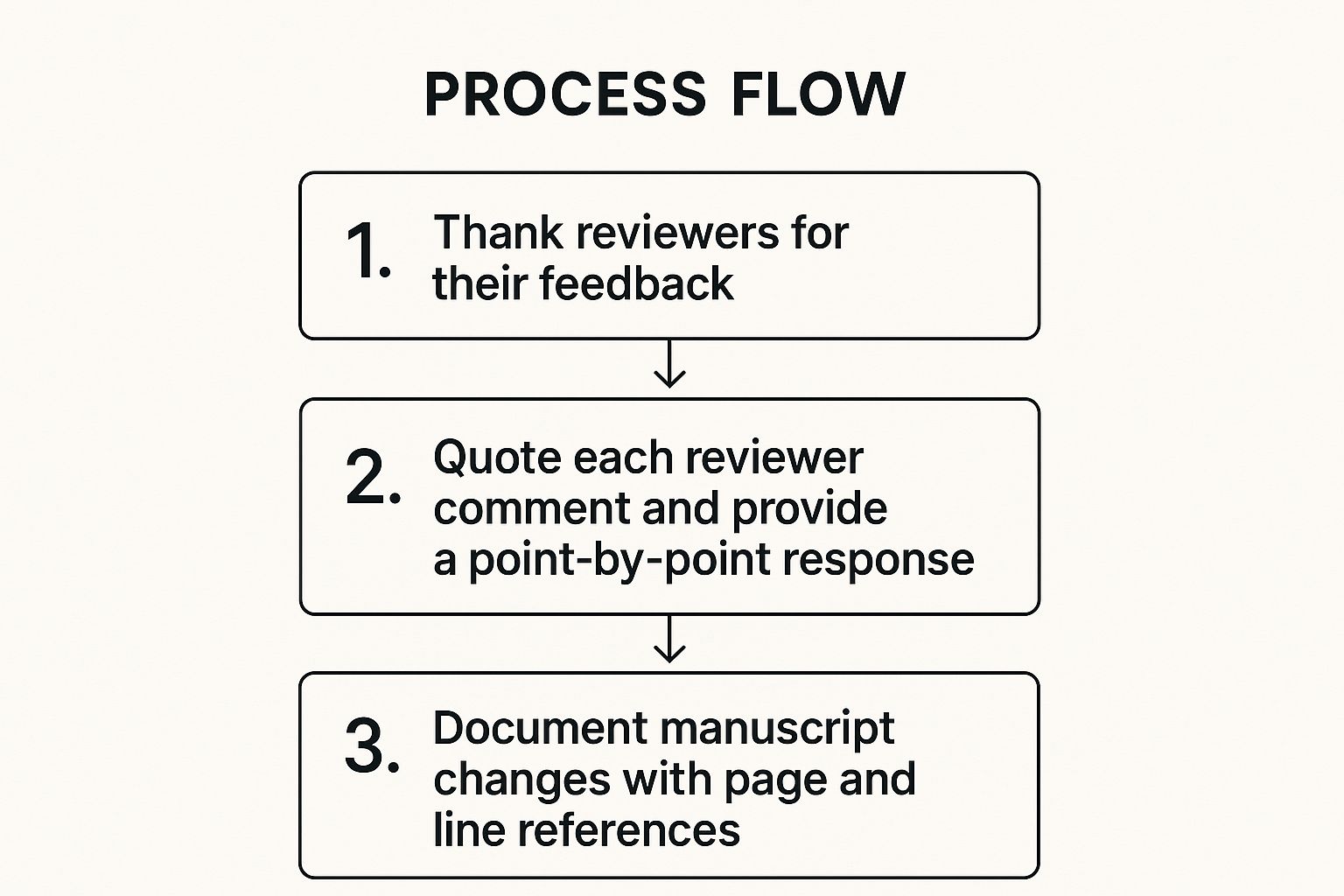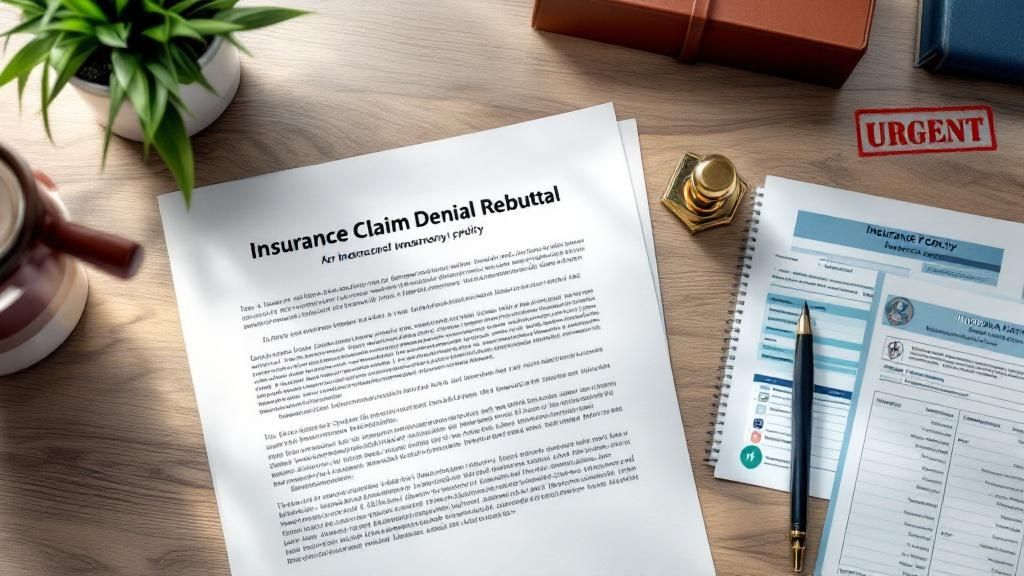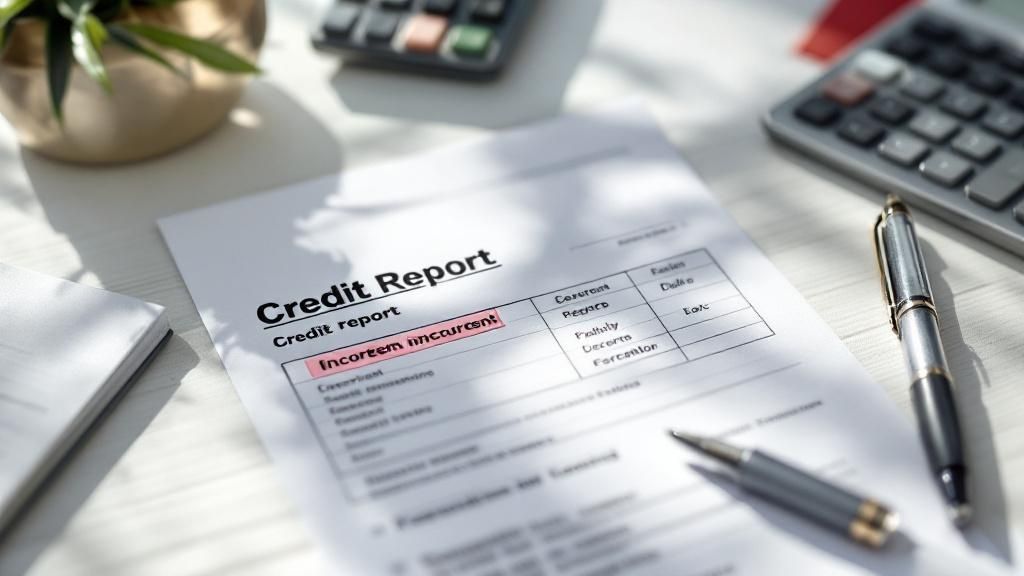
Ever felt like a decision went against you unfairly? Whether it’s a denied insurance claim, an incorrect credit report, a surprise tax assessment, or even a termination at work, that feeling of being wronged can be incredibly frustrating. Fortunately, a well-written rebuttal letter is your best tool for fighting back.
This isn't just about complaining; it's about presenting a structured, fact-based argument to set the record straight and formally challenge a decision. Knowing what to say, how to structure your points, and what evidence to include is the key to getting your case reconsidered. But staring at a blank page can feel overwhelming, especially when the stakes are high.
That’s where this guide comes in. We’re not just giving you generic templates. Instead, we'll break down six real-world scenarios, providing a detailed example of rebuttal letter for each one. We will look at the strategy behind the words, analyze the tactics used, and provide practical takeaways you can apply to your own situation. From academic appeals to insurance disputes, you'll learn how to build a compelling case that’s clear, professional, and difficult to ignore. Let's get started on turning that initial "no" into a potential "yes."
1. Academic Journal Peer Review Rebuttal Letter
In the world of academic research, a peer review rebuttal letter is a critical document that can determine whether years of work get published. When researchers submit a manuscript to a journal, it's evaluated by anonymous experts (peers) who provide feedback. This example of a rebuttal letter is the authors' formal response, addressing each concern point-by-point to persuade the journal editor that their work is solid and deserves publication.
This letter is a delicate balance of science and diplomacy. It requires researchers to defend their work with evidence while showing respect for the reviewers' expertise. A well-written rebuttal systematically explains changes made, clarifies misunderstandings, and politely disagrees with points when necessary, always backing up arguments with data or citations.
Strategic Breakdown
A successful academic rebuttal is more than just a list of answers; it's a persuasive dialogue. For instance, when a Stanford research team faced criticism about their sample size, they didn't just argue. They provided a new statistical power analysis that proved their sample was sufficient, directly addressing the concern with hard data. Similarly, when medical researchers submitting to the prestigious journal Nature were questioned about their methodology, they conducted extra experiments to strengthen their claims, showing a commitment to rigorous science.
The key is to treat the process as a constructive conversation, not a confrontation. Your goal is to work with the reviewers and editor to improve the manuscript and prove its value.
How to Write an Academic Rebuttal Letter
The structure is super important for clarity and impact. The following infographic outlines the essential steps for drafting a compelling response.

This process ensures your response is organized, easy for the editor to follow, and directly linked to the specific changes in your manuscript.
Actionable Tips for Success
- Start with Gratitude: Always begin by thanking the editor and reviewers for their time and insightful comments. This sets a collaborative, professional tone.
- Quote and Respond: Address every single reviewer comment. Copy the exact comment into your letter and write your response directly below it. This makes it easy to track.
- Be Specific with Changes: Don't just say you "clarified a section." State exactly what you did and where: "We have revised the paragraph on page 5, lines 112-120, to more clearly define the control group..."
- Disagree Respectfully: If you disagree with a comment, provide a strong, evidence-based reason. Cite supporting literature to back up your position. A polite but firm rebuttal is often respected.
By following this structured approach, researchers can navigate the peer review process effectively, significantly increasing their chances of publication. For a deeper dive into crafting effective responses, explore these detailed rebuttal letter examples.
2. Insurance Claim Denial Rebuttal Letter
When an insurance company denies a claim, it can feel like a final, frustrating verdict. However, a rebuttal letter is your formal opportunity to challenge this decision. This example of a rebuttal letter is a structured, evidence-based document that policyholders send to their insurer to contest a denial, arguing that the claim should be covered according to the policy's terms.

This letter isn't an emotional plea; it’s a business communication aimed at overturning a specific financial decision. A strong rebuttal presents new evidence, clarifies information, and directly references policy language to demonstrate why the denial was incorrect. It serves as a critical first step in the appeals process before escalating the issue.
Strategic Breakdown
A successful insurance rebuttal methodically dismantles the insurer's reason for denial using facts and documentation. For example, a patient whose claim for an MRI was denied as "not medically necessary" can submit a powerful rebuttal. This would include a detailed letter from their physician explaining the diagnostic importance of the scan, citing established medical guidelines.
Similarly, a homeowner whose storm damage claim was rejected based on an adjuster's report can counter with a report from an independent inspector. This new evidence directly contradicts the insurer's findings, forcing them to re-evaluate the claim's validity. The strategy is to counter the insurer's logic with superior, expert-backed evidence. This process shares similarities with disputing financial claims, as seen when you learn more about how to fight a chargeback.
How to Write an Insurance Rebuttal Letter
Clarity, evidence, and professionalism are your greatest assets. The letter must be easy to understand, well-supported, and direct in its request.
Actionable Tips for Success
- Reference Your Policy: Open your letter by stating your name, policy number, and the claim number. Reference the specific sections of your insurance policy that support your claim.
- Provide New Evidence: This is the core of your rebuttal. Include supporting documents like a doctor's letter, an independent contractor's estimate, police reports, or photos.
- State a Clear Outcome: Explicitly state what you want to happen. For example, "I am requesting that you reverse this denial and process my claim for the full amount of $X,XXX."
- Stay Factual, Not Emotional: While a claim denial is upsetting, keep your tone professional and objective. Stick to the facts of the case and the terms of your policy.
- Send via Certified Mail: Mail your letter and all supporting documents via certified mail with a return receipt requested. This provides proof that the insurance company received your appeal.
3. Employment Termination Rebuttal Letter
When an employee faces wrongful termination or an unfair performance review, a rebuttal letter is a crucial tool for defense. It serves as a formal, written response to contest an employer's claims. This example of a rebuttal letter is the employee's opportunity to present their side of the story, backed by facts, to challenge the company’s decision. It's an important document for internal appeals, unemployment claims, or potential legal action.
This letter is a strategic document that must be objective and evidence-based. It requires the employee to systematically refute the employer's stated reasons for termination, highlighting procedural errors, documenting discriminatory treatment, or providing clear evidence of retaliation. The goal is to create an official record that contradicts the employer's narrative.
Strategic Breakdown
A powerful employment rebuttal letter is built on facts, not emotions. For instance, an employee terminated for "poor performance" can successfully contest the decision by showing that all previous performance reviews were positive and that no formal warnings were ever issued. This transforms a subjective claim into a documented inconsistency on the employer's part. Similarly, a sales representative who was fired for not meeting a quota could show that other team members with similar or lower numbers were not terminated, suggesting discriminatory or unfair treatment.
The key is to dismantle the employer’s argument piece by piece using verifiable evidence. The letter isn't about venting frustration; it's about building a logical, fact-based case that is difficult for an HR department or a legal body to ignore. Your goal is to show that the termination was unfounded, procedurally flawed, or discriminatory.
How to Write an Employment Rebuttal Letter
A clear and professional structure is vital to making your case effectively. The letter should be organized, concise, and focused on your strongest arguments, ensuring it is taken seriously by HR or legal counsel.
The process ensures your response is coherent, easy to follow, and directly addresses the core issues of your termination.
Actionable Tips for Success
- Be Objective and Factual: Avoid emotional language, accusations, or personal attacks. Stick to a calm, professional tone and present only verifiable facts.
- Reference Specifics: Use exact dates, times, and direct quotes from conversations or documents. For example, "On March 15th, during my performance review with Jane Doe, she stated..."
- Provide Documentation: Include copies (never originals) of supporting evidence like positive performance reviews, emails, or commendations that contradict the termination reason.
- Keep it Concise: Focus on your two or three most compelling arguments. A long, rambling letter can dilute the impact of your strongest points.
- Get a Professional Review: Before sending, have an employment law attorney review your letter. Their expertise can be invaluable in strengthening your position.
By following this structured approach, you can create a compelling rebuttal that formally documents your side of the story and protects your professional reputation. For more guidance on structuring your response, you can find a helpful rebuttal letter template and additional examples.
4. Credit Report Error Rebuttal Letter (Dispute Letter)
An inaccurate credit report can lock you out of loans, housing, and even job opportunities. A credit report error rebuttal, commonly known as a dispute letter, is a formal document sent to credit bureaus like Experian, Equifax, or TransUnion. This example of a rebuttal letter formally challenges incorrect information, using your consumer rights under the Fair Credit Reporting Act (FCRA) to demand an investigation and correction.

This letter is a powerful tool for financial self-defense. It isn't an emotional plea but a factual, evidence-based request. A well-written dispute letter clearly identifies the error, explains why it's wrong, and provides supporting documentation to prove your claim, forcing the credit bureau to investigate with the entity that supplied the information.
Strategic Breakdown
A successful credit dispute letter is built on clarity and evidence. For instance, a consumer in Atlanta found a late payment on their report despite having proof of on-time payment. Their dispute letter didn't just state the payment was on time; it included a copy of the bank statement showing the transaction date, leaving no room for doubt. The bureau removed the error within 30 days.
Similarly, an identity theft victim cleared fraudulent accounts by submitting a dispute letter accompanied by a police report and a Federal Trade Commission (FTC) identity theft affidavit. This transforms the dispute from a simple claim into a documented legal issue that bureaus must address seriously. The strategy is to make your case undeniable by providing a clear paper trail.
How to Write a Credit Dispute Letter
The letter must be professional, direct, and easy for the investigator to understand. Your goal is to provide everything they need to make a decision in your favor without any back-and-forth. The process requires careful record-keeping and a firm, factual tone.
While similar to chargeback disputes, credit report errors require a specific approach focused on long-term credit health. Exploring how to effectively manage these financial disagreements can provide valuable insights. Learn more about the strategies needed to successfully win a credit card dispute.
Actionable Tips for Success
- One Error, One Dispute: If you have multiple errors, send a separate dispute letter for each one. This prevents confusion and creates a cleaner investigation trail for each item.
- Use Certified Mail: Always send your dispute letter via certified mail with a return receipt requested. This provides legal proof that the credit bureau received your correspondence and when.
- Include Copies, Not Originals: Attach copies of all supporting documents, such as bank statements, receipts, or police reports. Never send your original documents.
- Clearly Identify the Error: Include a copy of your credit report with the inaccurate item circled or highlighted. State precisely what is wrong and what the correct information should be.
- Follow Up: Credit bureaus generally have 30 days to investigate. If you don't hear back, send a follow-up letter referencing your original dispute and the certified mail receipt.
5. Tax Assessment Rebuttal Letter (Property Tax Appeal)
Challenging your property tax assessment is a common way for homeowners and commercial property owners to potentially lower their tax bills. An example of a rebuttal letter in this context is a formal appeal to your local tax assessor's office, arguing that your property's assessed value is too high. This letter presents factual evidence to persuade the review board that the assessment should be lowered to reflect its true fair market value.
This type of letter is a fact-based argument, not an emotional plea. It requires owners to act like detectives, gathering concrete evidence to build a case. A successful rebuttal systematically presents data like comparable sales, appraisal reports, or errors in the property's official record to justify a reduction in assessed value.
Strategic Breakdown
A strong tax appeal letter is built on irrefutable evidence, not just an opinion that the taxes are too high. For example, a homeowner in a cooling real estate market successfully reduced their assessment by 15% by providing data on three nearby, similar homes that sold for significantly less in the past six months. Their letter directly contrasted the assessor's older, higher-priced comparables with this recent, more relevant market data.
In another case, a commercial property owner won their appeal by submitting a contractor's report detailing structural issues that required expensive repairs. This documented evidence proved that the property's real-world condition was far worse than the assessor’s records suggested, directly impacting its market value. The key is to present a logical, evidence-backed argument that leaves the assessor little room for disagreement.
How to Write a Property Tax Rebuttal Letter
The success of your appeal hinges on clear, organized, and compelling documentation. Your goal is to make it easy for the assessor to understand your position and agree with your proposed valuation.
- State Your Purpose Clearly: Begin by identifying your property (by parcel number) and stating that you are appealing its current assessed value.
- Present Your Evidence: This is the core of your letter. Dedicate separate paragraphs or a bulleted list to each piece of evidence, such as comparable sales ("comps"), photos of property damage, or a professional appraisal report.
- Correct Any Factual Errors: If the assessor's records contain mistakes (e.g., incorrect square footage, wrong number of bathrooms), point them out clearly.
- Propose a New Value: Conclude by suggesting a specific, evidence-based assessed value that you believe is fair and accurate.
Actionable Tips for Success
- Mind the Deadlines: Appeal deadlines are strict and non-negotiable. Research and note your local deadline as soon as you receive your assessment.
- Gather Strong Comps: Find 3-5 truly comparable properties that have recently sold for less than your assessed value. "Comparable" means similar in location, size, age, and condition.
- Document Everything: Take clear photos of any defects, damage, or negative conditions (like proximity to a loud highway) that could lower your property's value.
- Check the Assessor's Math: Request your property's record card from the assessor’s office. Scrutinize it for any factual errors, like an extra bedroom or an overstated lot size.
- Be Professional: Keep your tone respectful and business-like. Present your case with organized documentation, making it easy for the reviewer to follow your logic.
By building a case grounded in solid evidence, property owners can effectively use a rebuttal letter to challenge an unfair assessment and potentially save a significant amount on their tax bill.
6. Academic Grade Appeal Rebuttal Letter
Receiving a final grade that seems incorrect or unfair can be disheartening, but an academic grade appeal rebuttal letter provides a formal pathway for students to challenge it. This example of a rebuttal letter is a structured argument sent to a professor or an appeals committee. It's designed to prove that a grade was a result of a calculation error, a violation of syllabus policy, or inconsistent evaluation.
This letter isn't about simply disagreeing with a grade; it's about presenting a fact-based case. The student must act as a respectful advocate for their own academic record, using evidence to demonstrate why the grade deserves reconsideration. The goal is to correct a verifiable mistake, not to negotiate for a better outcome based on effort alone.
Strategic Breakdown
A powerful grade appeal focuses on objective evidence, not subjective feelings. For instance, a student at a large public university successfully appealed a grade after discovering their final exam score was entered incorrectly into the digital gradebook. Their appeal included a screenshot of the correct exam score and a clear calculation showing the impact on their final grade, making the error undeniable.
In another case, an instructor began penalizing students for attendance halfway through the semester, a policy not mentioned in the official syllabus. A student's appeal succeeded by highlighting this discrepancy, citing the syllabus as a binding contract. The key is to anchor your argument in official documents and verifiable facts, removing emotional pleas from the equation.
How to Write an Academic Grade Appeal Letter
A successful appeal is built on clear, organized, and respectful communication. The process requires careful documentation and a focus on institutional policy.
Following these steps ensures your appeal is taken seriously and addresses the core issues without getting sidetracked by frustration.
Actionable Tips for Success
- Check the Policies First: Before writing, carefully review your institution's specific grade appeal procedures and deadlines. Missing a deadline can invalidate your claim.
- Focus on Facts, Not Feelings: Center your argument on objective issues like mathematical errors, grading criteria not listed in the syllabus, or procedural inconsistencies. Avoid arguments like "I worked really hard."
- Document Everything: Save all graded assignments, emails with the instructor, and the course syllabus. This documentation is your evidence.
- Be Professional and Respectful: Maintain a courteous tone throughout your letter, even if you are upset. An aggressive or accusatory tone will undermine your credibility. The principles of handling disputes professionally are universal, much like those discussed when you learn more about managing customer complaints.
Comparison of 6 Rebuttal Letter Examples
Mastering the Art of the Rebuttal: Your Next Steps
We've walked through a variety of situations where a well-written rebuttal letter can make all the difference. From an academic journal submission to a disputed property tax bill, the core principles of a successful rebuttal remain surprisingly consistent. The most effective arguments are not built on emotion or frustration, but on a solid foundation of evidence, logic, and clarity.
Looking back at each example of rebuttal letter, you can see a clear pattern. The writer always remains professional, even when faced with a frustrating denial or a clear error. They methodically dismantle the opposing argument by presenting verifiable facts, referencing specific documents, and structuring their points in a way that is easy for the reader to follow. This structured, evidence-first approach is the key to turning a "no" into a "yes."
Core Strategies to Remember
The real power of a rebuttal lies in how you put it together. It’s more than just writing a letter; it's about building a compelling case. As you prepare your own response, keep these critical takeaways in mind:
- Lead with Facts, Not Feelings: Your strongest asset is objective evidence. In every example, from the insurance claim denial to the employment termination letter, proof was the centerpiece of the argument. Invoices, timestamps, expert opinions, or dated correspondence will always be more persuasive than personal feelings.
- Maintain a Professional Tone: Your tone sets the stage for how your argument will be received. A calm, respectful, and confident voice encourages the recipient to engage with your points seriously. An angry or accusatory tone can shut down the conversation before it even begins.
- Structure for Clarity: Use headings, bullet points, and short paragraphs to make your letter easy to scan and understand. The person reading your rebuttal is likely busy. A clear, well-organized document respects their time and makes it easier for them to agree with you.
- Propose a Clear Solution: Don't just point out the problem. State exactly what you want to happen next. Whether it's the reversal of a charge, the correction of a record, or the approval of a claim, a clear call to action removes any doubt and provides a path forward.
Mastering these skills extends beyond just writing rebuttals. The ability to present a logical, evidence-based argument is a valuable tool in all forms of professional communication. For broader insights into composing well-structured and impactful correspondence, you might also review guides on crafting effective persuasive letters.
Ultimately, each example of rebuttal letter we’ve analyzed serves as a blueprint. You now have the strategic framework and practical insights needed to advocate for yourself or your business with confidence. By staying organized, gathering your evidence, and presenting your case with professionalism, you can protect your interests and achieve the resolution you deserve.
Tired of manually fighting chargebacks? ChargePay uses AI to automatically generate evidence-based rebuttal letters tailored to each dispute, saving you time and recovering lost revenue. Let our technology build your winning case so you can focus on growing your business.







.svg)







.svg)
.svg)
.svg)